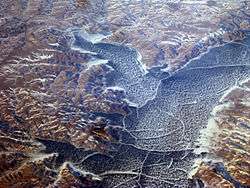Lake Oahe
| Lake Oahe | |
|---|---|
 Lake Oahe in winter, 2009 | |
| Location | South Dakota, North Dakota |
| Coordinates | 44°27′04″N 100°24′08″W / 44.45111°N 100.40222°WCoordinates: 44°27′04″N 100°24′08″W / 44.45111°N 100.40222°W at Oahe Dam |
| Lake type | reservoir |
| Primary inflows | Missouri River, Cheyenne River, Moreau River, Grand River |
| Primary outflows | Missouri River |
| Basin countries | United States |
| Max. length | 231 mi (372 km)[1] |
| Surface area | 370,000 acres (150,000 ha)[1] |
| Max. depth | 205 ft (62 m)[1] |
| Water volume | 23,500,000 acre·ft (29.0 km3)[2] |
| Shore length1 | 2,250 mi (3,620 km)[1] |
| Surface elevation | 1,647 ft (502 m) |
| 1 Shore length is not a well-defined measure. | |
Lake Oahe (oh-WAH'-hee) is a large reservoir behind Oahe Dam on the Missouri River; it begins in central South Dakota and continues north into North Dakota in the United States. The lake has an area of 370,000 acres (1,500 km2) and a maximum depth of 205 ft (62 m).[1] By volume, it is the fourth-largest reservoir in the US.[1] Lake Oahe has a length of approximately 231 mi (372 km) and has a shoreline of 2,250 mi (3,620 km).[1] 51 recreation areas are located along Lake Oahe,[3] and 1.5 million people visit the reservoir every year.[1] The lake is named for the 1874 Oahe Indian Mission.[3]
Species of fish in the reservoir include walleye, northern pike, channel catfish, and smallmouth bass.[4] Chinook Salmon, native to the Pacific Northwest, are artificially maintained in Lake Oahe and are a popular target for anglers.[4][5] The lake also supports populations of the endangered pallid sturgeon.[1]
Lake Oahe begins just north of Pierre, South Dakota and extends nearly as far north as Bismarck, North Dakota. Mobridge, South Dakota is located on the eastern shore of the central portion of the lake. A map centered on Mobridge 45°32′14″N 100°25′40″W / 45.53722°N 100.42778°W probably gives the best view of the extent of the lake. Bridges over Lake Oahe include US Route 212 west of Gettysburg, South Dakota and US Route 12 at Mobridge. The former town of Forest City has been flooded beneath Lake Oahe, about 9 miles west of Gettysburg. Prehistoric archeological sites have been explored in the area, including Molstad Village near Mobridge. It dates to before the emergence of the Arikara, Hidatsa and Mandan as separate peoples, and has been designated as a National Historic Landmark.
Both the Cheyenne River Indian Reservation and the Standing Rock Indian Reservation occupy much of the western shoreline of Lake Oahe. Two possible burial sites of Sitting Bull, a Sioux leader, are located along Lake Oahe.[6] One is near Fort Yates, North Dakota, while the other is near Mobridge.[6]
Forced relocation of Native Americans during construction
In the 1960s, the Army Corps of Engineers and the Bureau of Reclamation built five large dams on the Missouri River, and implemented the Pick–Sloan Missouri Basin Program, forcing Native Americans to relocate from flooded areas. Over 200,000 acres on the Standing Rock Reservation and the Cheyenne River Reservation in South Dakota were flooded by the Oahe Dam alone. As of 2015, poverty remains a problem for the displaced populations in the Dakotas, who are still seeking compensation for the loss of the towns submerged under Lake Oahe, and the loss of their traditional ways of life.[7]
See also
References
- 1 2 3 4 5 6 7 8 9 "Oahe Dam & Lake" (PDF). United States Army Corps of Engineers. Retrieved 2010-04-26.
- ↑ "Gavins Point Dam & Power Plant". United States Army Corps of Engineers. Retrieved 2010-04-26.
- 1 2 "Corps Lakes Getaway: Oahe Dam/Lake Oahe". United States Army Corps of Engineers. Retrieved 2010-04-26.
- 1 2 "2010 Lake Oahe Fishery Projections" (PDF). South Dakota Department of Game, Fish and Parks. Retrieved 2010-04-26.
- ↑ "Chinook Salmon". Northern State University. Retrieved 2008-08-09.
- 1 2 Barry, Dan. Restoring Dignity to Sitting Bull, Wherever He Is The New York Times. January 28, 2007. (accessed 2010-04-26)
- ↑ Lee, Trymaine. "No Man's Land: The Last Tribes of the Plains. As industry closes in, Native Americans fight for dignity and natural resources". MSNBC - Geography of Poverty Northwest. Retrieved 2015-09-28.